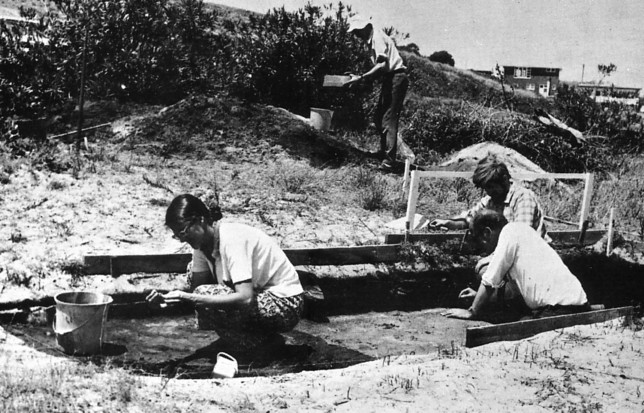 THE
SWANSEA-HEADS MIDDEN THE
SWANSEA-HEADS MIDDEN
by L.K. Dyall
Preamble
Physical evidence of Aboriginal occupation used to be abundant
along the ocean shoreline between Catherine Hill Bay and Newcastle.
Almost invariably, these sites had been reduced by natural erosion
to scatters of stone artefacts and shells, and only limited information
could be obtained from them. Sites of this sort cannot be usefully
dated. By the late 1960's, nearly all of these sites had been
destroyed by urban development and rutile mining.
In 1971, clearing of land at Swansea Heads for
a housing estate uncovered a very promising midden. It contained
large quantities of fish and mammal bone, as well as remains of
edible shellfish and numbers of stone artefacts. The deposit of
midden material was virtually undisturbed and could therefore
yield useful dates. This place had also been used as a burial
ground.
Back in those times, the legal protection for
such a valuable site was unsatisfactory. Aboriginal Land Councils
were not yet effectively established, and it was left to the National
Parks and Wildlife Service NPWS) to do what they could with inadequate
funding. In this case, the NPWS could not afford the retaining
walls needed to stop the burial ground and midden being washed
by rainstorms into the Swansea Channel. This situation called
for an urgent "rescue dig" to salvage as much information
as possible and recover the human burials.
No NPWS archaeologists or funding were available.
Essentially, Frances Bentley and 1 were given an excavation permit
and told to do what we could with volunteer labour and skills.
Fortunately, the owners of the land were most helpful (they delayed
building their house for three months), and enthusiastic volunteers
for the excavation were never wanting. The Australian Institute
of Aboriginal Studies contributed some funding for radiocarbon
dates.
The "dig"
The excavation took place between September and November 1972,
and occupied 43 field days. In the much longer phase of sorting,
identifying, and interpreting material, we had generous help from
the staff of The Australian Museum, a number of professional archaeologists,
and many experts in other fields drawn from both The University
of Newcastle and The University of Sydney.
The results
The site had been occupied nearly 8000 years. Such an early occupation
was a surprise, since the shoreline with its rich food resources
was not close by in those times. However, the early occupation
was quite thin. Not until 2700 years ago did intensive occupation
set in, and the midden then became a solid mass of shells, faunal
bones, charcoal, and stone artefacts. The human burials belong
to this recent phase of intense occupation. There is historical
evidence that the site was still occupied in 1820 AD. However,
19th century lime-burners had dug away the upper part of the midden,
whose surface when we found it was dated as 2000 years old.
Stone tools were fabricated on the site in large
quantities, using locally-available tuffites as raw material.
The commonest tools were the small, delicate knives known as "bondi
points", but a wide range of other tool types were also present.
The long bones of mammals were usually broken into slivers and
made into points, possibly for use in fish spears.
The range of faunal remains recovered from 17
cubic metres of the rnidden is impressive. Much of this material
was charred or broken, but there were at least 42589 shellfish,
10 11 fish, 89 mammals, 20 birds, 11 reptiles and several turtles.
This array of food sources indicates a highly developed hunting
and gathering strategy. Although the site is alongside the Channel,
the people who camped here did not restrict themselves to marine
food, but hunted in the bush as well. The species of identified
fish came from both the Channel and the rock platforms, and the
presence of many sardine-sized fish suggests the use of tidal
fish traps.
The human remains were extensively studied, with
the permission of the Bahtabah Local Aboriginal Land Council,
and have since been reburied close to the original burial ground.
The results of these studies are restricted information.
Len Dyall, 24 September 2002
|


 THE
SWANSEA-HEADS MIDDEN
THE
SWANSEA-HEADS MIDDEN